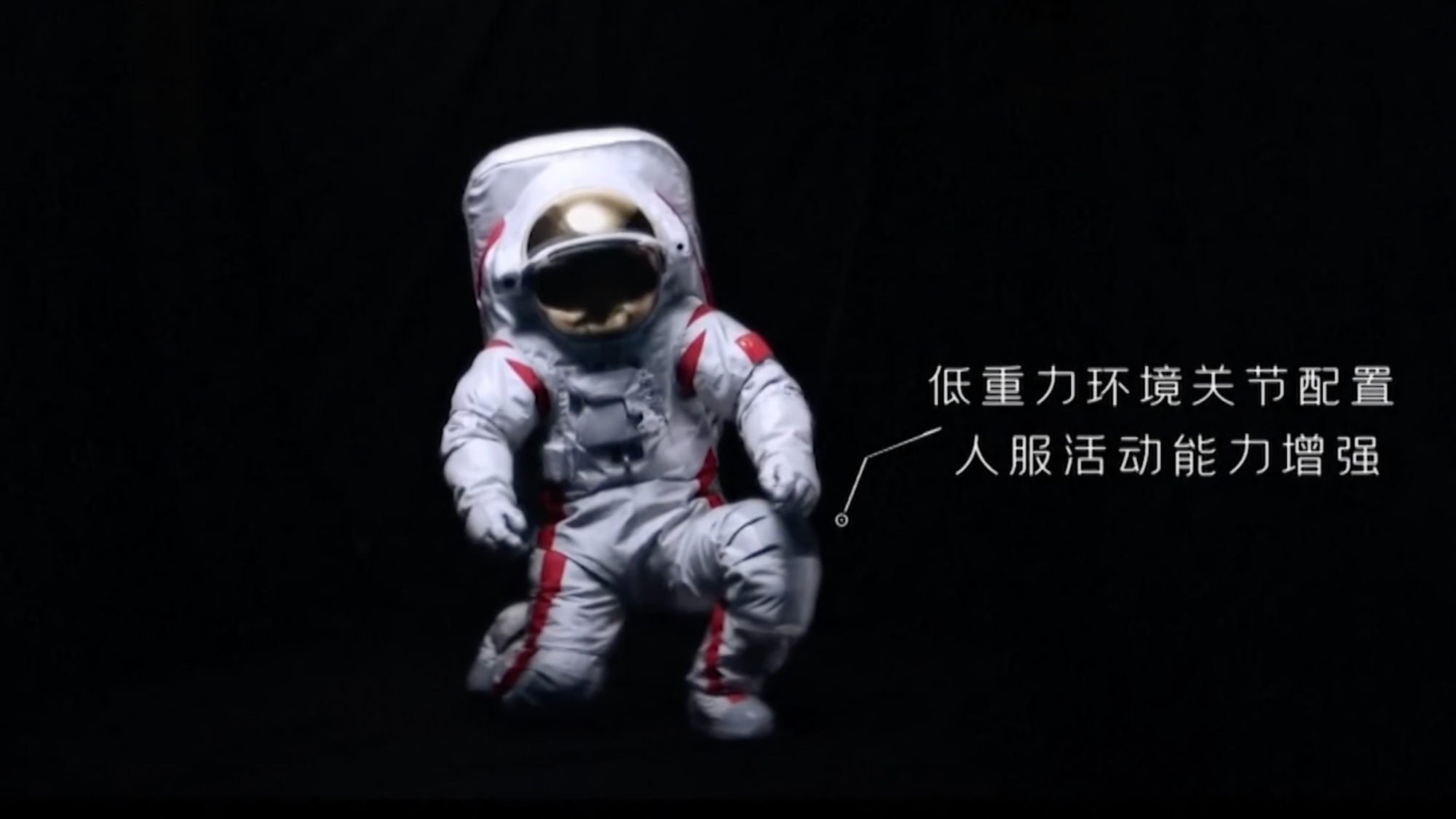China unveils spacesuit for moonwalking astronauts (video)

The nation aims to put boots on the moon by 2030.
China has strutted out its moon-landing spacesuit, unveiling its design in a ceremony Saturday (Sept. 28) in southwest China's Chongqing Municipality.
A technician put the spacesuit — which China aims to start using on crewed moon missions by 2030 — through its paces, showcasing various movements and gestures, including climbing the rungs of a ladder.
The overall design of the moon-landing suit is inspired by traditional Chinese armor, underscoring the suit's rugged and resolute appearance. It also features ribbons, which have always been an important element in the design of Chinese spacesuits.
Multi-use suit
The new lunar suit is an evolution of the Feitian, China's first indigenous spacesuit. Feitian means "flying in the sky" and is the name of a legendary Buddhist goddess.
Related: China unveils video of its moon base plans, which weirdly includes a NASA space shuttle
"The Feitian extravehicular activity suit is designed for use in low Earth orbit, where astronauts float in a microgravity environment," said Zhang Wanxin, director of the Spacesuit Engineering Office and deputy chief designer of the Astronaut System at the China Astronaut Research and Training Center.
"Therefore, we chose the ribbon element to convey a sense of free flow," Zhang told state broadcaster China Central Television (CCTV). "The moon-landing suit is designed for lunar explorations such as walking and working on the moon's surface, so we would also like to convey a strong-willed and unswerving feeling, which we integrated organically into the suit's design."
Breaking space news, the latest updates on rocket launches, skywatching events and more!
Following the suit demonstration, Yang Liwei, deputy chief designer of China's crewed space program and China's first astronaut, together with the technician, launched a public campaign to name the new moon spacesuit. This campaign will close on Oct. 31, 2024.
Experts on China's first-ever lunar spacesuit provided additional details on the lightweight, flexible garment.
According to CCTV, the suit's attributes include:
- A comprehensively protective fabric that shields against the harsh thermal environment and lunar dust
- A panoramic glare-proof visor for improved vision
- Two cameras on the sides of the helmet for video recording
- A multi-functional control console on the chest that streamlines operations for greater efficiency.
Changes in posture
In contrast to China's current Feitan spacesuit, "the new one is mainly designed to be lightweight, catering to the demands of activities in a low-gravity environment, with configurations that allow for squatting and bending with ease," CCTV reports.
According to Wang Chunhui, deputy chief designer of astronaut training systems at the China Astronaut Research and Training Center, the suit's fit must remain unaffected by changes in posture to accommodate the various positions that will be required on the moon.
"The suit allows for more actions. So in various postures, the fitness shouldn't be affected after a posture change. Therefore it requires a better fit on the human body," Wang told CCTV, adding that the suit is more like regular clothes compared with other extravehicular spacesuits.
Complex environmental factors
"Different from performing low Earth orbit missions, astronauts will be exposed to a naturally harsh lunar environment when carrying out lunar-surface extravehicular activities," said Wu Zhiqiang, another designer of astronaut training systems at the China Astronaut Research and Training Center.
"Complex environmental factors such as high vacuum and low gravity, dust and moon soil, complex surface topography, high and low temperatures [and] strong radiation will have a big impact on the work and protection of astronauts," Wu told CCTV.
"Considering that they are working under one-sixth gravity, in order to reduce the metabolic load of the human body, it is a must to greatly reduce the suit's weight," said Wu.
"As astronauts will walk on the lunar surface and carry out scientific research activities, the spacesuits must have better ergonomic support capabilities, and be smaller and more integrated. And the comprehensive protection capability of lunar-landing boots must also be greatly improved," he said.
You can watch the suit unveiling ceremony here.

Leonard David is an award-winning space journalist who has been reporting on space activities for more than 50 years. Currently writing as Space.com's Space Insider Columnist among his other projects, Leonard has authored numerous books on space exploration, Mars missions and more, with his latest being "Moon Rush: The New Space Race" published in 2019 by National Geographic. He also wrote "Mars: Our Future on the Red Planet" released in 2016 by National Geographic. Leonard has served as a correspondent for SpaceNews, Scientific American and Aerospace America for the AIAA. He has received many awards, including the first Ordway Award for Sustained Excellence in Spaceflight History in 2015 at the AAS Wernher von Braun Memorial Symposium. You can find out Leonard's latest project at his website and on Twitter.

